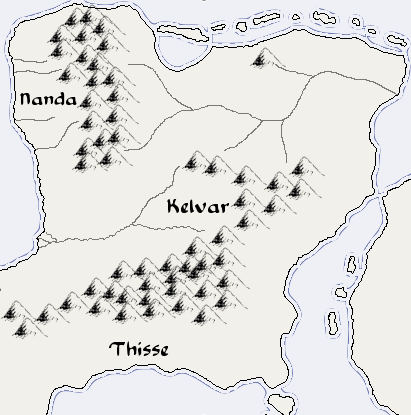 Every good story needs a setting. Whether that’s a real one (say, New York), a pre-made one (for example The Forgotten Realms) or a completely new made-up one.
Every good story needs a setting. Whether that’s a real one (say, New York), a pre-made one (for example The Forgotten Realms) or a completely new made-up one.
Sometimes it just serves as a background for the story to take place somewhere. Sometimes it becomes an entire universe in itself (like Discworld). The important thing is to get it right. If your entire story takes place inside a roadside diner, does it really matter whether it is in Texas or in Iowa? But if your characters are tramping across a continent, you need to know where the hell they are, or you will trip yourself up. And your readers.
Fair enough, if you’re about to write a fantastic story, you don’t want to get bogged down with creating a whole world before you even start (unless you’re Ian Irvine). You can make it up as you go along. However, it is absolutely vital to keep track of what you’re creating. If you don’t, your characters get lost. Which means your readers get lost, too. And that can ruin a great story.
Navigation: Tell the readers where they are
A while ago I read a series of novels that had some maps at the front of the books. Yay, I like maps. I look at them all the time, to track where the characters are, how far they’ve come or how far they still have to go. However, while all the places mentioned in the first novel were there, the further I got with the series, the more I came across places that were somewhere… between. I kept hoping for a more detailed map of a particular region to be included in the next volume, but I was stuck with what I had. The big places were clearly marked – every city had its dot. But sometimes the important places aren’t big at all. For example, the clearing in the woods where a hero comes to a life-changing decision. I don’t care about the far-off capital, I want to know where that bloody forest is!
In this particular set of novels, more and more storyline in the later volumes started to take place in areas that weren’t clearly marked on the initial maps. They were included, yes, but more in a “Here Be Dragons”-sort of way, that waves a hand at pretty much any place beyond the mountains over there.
I still enjoyed the story very much, but I had to stop and look at the maps a LOT more often to keep track of where the heck I am. Rather than giving me a fixed reference point that I can look up, I had to keep remembering that I’m somewhere north of this place, but not so far that I’m already west of that place, but the characters are still on the grassy plains, so I can’t be at those mountains yet…
The author, having spent an enormous amount of time thinking about and then creating this particular neck of the woods, knows exactly where they are. The reader however, having nothing to go on but those maps and some directions from the plot, has to perform constant mental triangulation while trying to follow the storyline. I’d rather have a better map and only concentrate on the story.
Continuity: Remember where they’ve been before
Another example of bad world building is making the map afterwards. If you don’t keep track of where you’ve been before, chances are you’re getting it wrong. Yes, even if the whole thing is your brainchild and you think you know the place like the back of your hand.
One best-selling author once accidentally drowned a minor character, who had a lucky escape and continued to live because the author didn’t notice. How? Early in the story, a character passes a signpost on his way from place A to place B. While this has no consequences for the character or the story at the time, the reader learns by way of description that a certain place C lies so-many miles (let’s say 50 miles) due north of that cross-road.
Nothing happens in place C for several volumes. When the story eventually comes to C a long time later, there’s a huge lake immediately to the south, stretching for let’s say 100 miles. While place C and the lake are on the map, it completely tripped me up. Remember that guy from the first volume? According to the maps and the current storyline, the cross-road he passed several books ago should be at the bottom of the lake.
It would have been different if the landscape had changed in the meantime. A meteor crashed and made a big crater. A dam broke and flooded the valley. Crazy wizards floated the city to a new place on a lake-shore. Anything you like. But nothing that drastic had happened there. Everything was where it was supposed to be, apart from the tiny fact that two different places accidentally occupied the same space.
Admittedly, a lot of readers won’t even remember that guy at this point. Let alone the signpost. But for those who do, it creates a hole in the story that doesn’t fit in with the rest. You can’t get away with that. If the readers can’t rely on the maps you gave them, it’s that whole triangulation business all over again.
And most important of all:
Detailed maps are cool.
Fact.